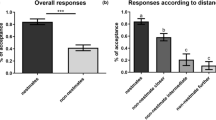Abstract
In group-level recognition, discriminators use sensory information to distinguish group members and non-members. For example, entrance guards in eusocial insect colonies discriminate nestmates from intruders by comparing their odour with a template of the colony odour. Despite being a species-rich group of eusocial bees closely related to the honey bees, stingless bee nestmate recognition is a relatively little-studied area. We studied Frieseomelitta varia, a common Brazilian species of stingless bee known as marmelada. By measuring the rejection rates of nestmate and non-nestmate worker bees by guards, we were able to show that guards became significantly less accepting (from 91 to 46%) of nestmates that had acquired odour cues from non-nestmate workers; however, guards did not become significantly more accepting (from 31 to 42%) of non-nestmates that had acquired equivalent amounts of odour cues from the guard’s nestmates. These data strongly suggest that guards use an “undesirable–absent” system in recognition, whereby incoming conspecific workers are only accepted if undesirable cues are absent, despite the presence of desirable cues. We suggest that an undesirable–absent system is adaptive because robbing by conspecifics may be an important selective factor in F. varia, which would lead to selection for a non-permissive acceptance strategy by guards.



Similar content being viewed by others
References
Biesmeijer JC, Slaa EJ (2004) Information flow and organization of stingless bee foraging.. Apidologie 35:143–157
Breed MD, Page RE (1991) Intraspecific and interspecific nestmate recognition in Melipona workers (Hymenoptera, Apidae).. J Insect Behav 4:463–469
Breed MD, Rogers KB (1991) The behavioral-genetics of colony defense in honeybees—genetic-variability for guarding behavior.. Behav Genet 21:295–303
Breed MD (1998) Recognition pheromones of the honey bee.. Bioscience 48:463–470
Breed MD, Leger EA, Pearce AN, Wang YJ (1998) Comb wax effects on the ontogeny of honey bee nestmate recognition. Anim Behav 55:13–20
Breed MD, Perry S, Bjostad LB (2004) Testing the blank slate hypothesis: why honey bee colonies accept young bees.. Insectes Sociaux 51:12–16
Buchwald R, Breed MD (2005) Nestmate recognition cues in a stingless bee, Trigona fulviventris.. Anim Behav 70:1331–1337
Butler CB, Free JB (1952) The behaviour of worker honeybees at the hive entrance.. Behaviour 4:262–292
Dani F, Jones G, Corsi S, Beard R, Pradella D, Turillazzi S (2005) Nestmate recognition cues in the honey bee: differential importance of cuticular alkanes and alkenes.. Chem Senses 30:477–489
Downs SG, Ratnieks FLW (2000) Adaptive shifts in honey bee (Apis mellifera L.) guarding behavior support predictions of the acceptance threshold model.. Behav Ecol 11:326–333
Free JB (1977) The social organization of the honey bees. Edward Arnold, London
Gamboa G, Grudzien T, Espelie K, Bura E (1996) Kin recognition pheromones in social wasps: combining chemical and behavioural evidence.. Anim Behav 51:625–629
Getz WM (1991) The honey bee as a model kin recognition system. In: Hepper PG (ed) Kin recognition. Cambridge University Press, Cambridge, pp 358–412
Hölldobler B, Michener CD (1980) Mechanisms of identification and discrimination in social Hymenoptera.. In: Markl H (ed) Evolution of social behavior: hypotheses and empirical tests. Verlag Chemie, Weinheim, pp 35–58
Hölldobler B, Wilson EO (1990) The ants. Harvard University Press, Cambridge
Howard RW (1993) Cuticular hydrocarbons and chemical communication.. In: Stanley-Samuelson DW, Nelson DR (eds) Insect lipids: chemistry, biochemistry and biology. University of Nebraska Press, Lincoln, pp 179–226
Inoue T, Roubik DW, Suka T (1999) Nestmate recognition in the stingless bee Melipona panamica (Apidae, Meliponini).. Insectes Sociaux 46:208–218
Jungnickel H, da Costa AJS, Tentschert J, Patricio E, Imperatriz-Fonseca VL, Drijfhout F, Morgan ED (2004) Chemical basis for inter-colonial aggression in the stingless bee Scaptotrigona bipunctata (Hymenoptera: Apidae).. J Insect Physiol 50:761–766
Kirchner WH, Friebe R (1999) Nestmate discrimination in the African stingless bee Hypotrigona gribodoi Magretti (Hymenoptera: Apidae). Apidologie 30:293–298
Lorenzi M, Bagneres A, Clement J (1996) The role of cutiuclar hydrocarbons in social insects: is it the same in paper-wasps? In: Turillazzi S, West-Eberhard MJ (eds) Natural history and evolution of paper wasps. Oxford University Press, Oxford, pp 178–189
Lubbock SJ (1882) Ants, bees and wasps: a record of observations on the habits of the social Hymenoptera. Kegan Paul, Trench, Trubner, London
Michener CD (2000) The bees of the world. Johns Hopkins University Press, Baltimore
Nogueira-Neto P (1997) Vida e criação de abelhas indigenas sem ferrão, São Paulo
Reeve HK (1989) The evolution of conspecific acceptance thresholds.. Am Nat 133:407–435
Seeley TD (1985) Honeybee ecology. Princeton University Press, Princeton
Sherman PW, Reeve HK, Pfennig DW (1997) Recognition systems.. In: Krebs JR, Davies NB (eds) Behavioural ecology. Blackwell Science, Oxford, pp 69–96
Suka T, Inoue T (1993) Nestmate recognition of the stingless bee Trigona-(Tetragonula)-Minangkabau (Apidae, Meliponinae).. J Ethol 11:141–147
Wood M, Ratnieks F (2004) Olfactory cues and Vespula wasp recognition by honey bee guards.. Apidologie 35:461–468
Acknowledgments
We thank Dr. Paulo Nogueira-Neto for his wonderful hospitality and expertise in stingless bee biology. We also thank Peter Mitchell for his help with the analysis. We declare that, to the best of our ability, these experiments comply with the current laws of the country in which they were performed. MJC was funded by a Graduate Research Fellowship from the National Science Foundation, USA.
Author information
Authors and Affiliations
Corresponding author
Additional information
Communicated by M. Giurfa
Rights and permissions
About this article
Cite this article
Couvillon, M.J., Ratnieks, F.L. Odour transfer in stingless bee marmelada (Frieseomelitta varia) demonstrates that entrance guards use an “undesirable–absent” recognition system. Behav Ecol Sociobiol 62, 1099–1105 (2008). https://doi.org/10.1007/s00265-007-0537-5
Received:
Revised:
Accepted:
Published:
Issue Date:
DOI: https://doi.org/10.1007/s00265-007-0537-5




